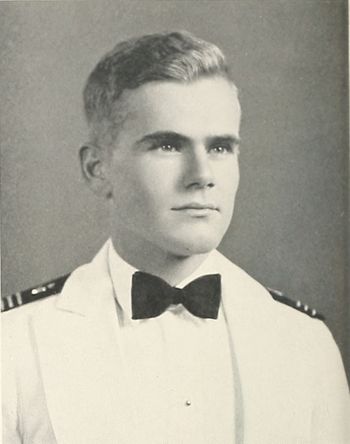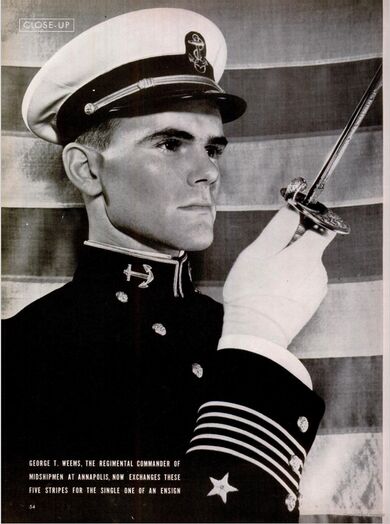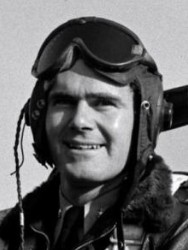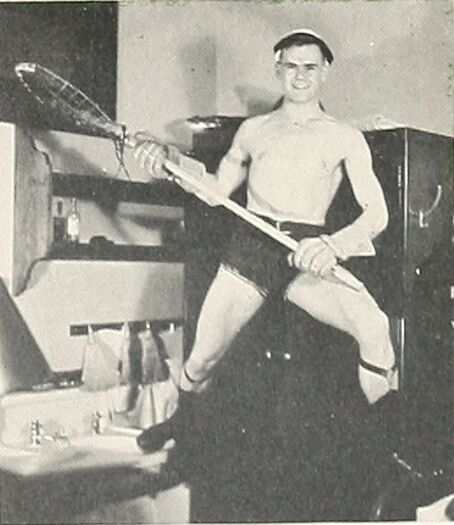GEORGE T. WEEMS, LCDR, USN
George Weems '42
Lucky Bag
From the 1942 Lucky Bag:
GEORGE THACKRAY WEEMS
Annapolis, Maryland
Bee, Ace, Smeew
Possessed with phenomenal luck and a ready laugh, Bee is one of the most popular members of his class. An outstanding athlete and Navy junior, he is supreme potentate of the Trident Society, expert sailor, versatile but not well-loved musician, inveterate chow-hound, ardent bunk-drill artist, all while maintaining a high academic standing.
Soccer 4, 2, 1, aNAf; Westling 4, 3, 2, wNt, Eastern Intercollegiate Wrestling Champion; Lacrosse 4, 3, 2, N; Class Vice-President; Trident, President; Quarterdeck 4, 3, 2; Boat Club 2; Foreign Language Club 4, 3, 2; 5 Stripes.
The Class of 1942 graduated on December 19, 1941, less than two weeks after the United States entered World War II. The class had previously been scheduled to graduate in February 1942.

GEORGE THACKRAY WEEMS
Annapolis, Maryland
Bee, Ace, Smeew
Possessed with phenomenal luck and a ready laugh, Bee is one of the most popular members of his class. An outstanding athlete and Navy junior, he is supreme potentate of the Trident Society, expert sailor, versatile but not well-loved musician, inveterate chow-hound, ardent bunk-drill artist, all while maintaining a high academic standing.
Soccer 4, 2, 1, aNAf; Westling 4, 3, 2, wNt, Eastern Intercollegiate Wrestling Champion; Lacrosse 4, 3, 2, N; Class Vice-President; Trident, President; Quarterdeck 4, 3, 2; Boat Club 2; Foreign Language Club 4, 3, 2; 5 Stripes.
The Class of 1942 graduated on December 19, 1941, less than two weeks after the United States entered World War II. The class had previously been scheduled to graduate in February 1942.
Loss
George was lost on January 16, 1951 when the aircraft he was piloting
From Class History: 1942:
The second member of '42 to gain early access to flying was the former regimental commander, George "Bee" Weems, the head "striper" of the Class. While participating in aerial combat near the end of the War, he shot down four Japanese planes in about twenty minutes during one flight. His exploits were of great interest to his classmates still undergoing training and he kept them informed by mail of the lessons he was learning. Weems survived the War and went on to test pilot duty at Patuxent, Maryland where on 16 January 1951, he was killed in a freak accident involving a floatplane in which he was not even the pilot.
Other Information
The accident occurred in the Delaware River; the pilot was a civilian. Unable to find details, but he was survived by his wife and at least one child. (His granddaughter, Gwen Manseau, edited his book, below.)
He has a memorial marker at the Naval Academy Cemetery.
LIFE Magazine
LIFE Magazine did a multi-page spread on George in the December 29, 1941 issue.
Wartime Service
From SS Arkansan, discussing the aftermath of the Battle of Cape Esperance:
Immediately following the night action, McCalla was tasked with finding the badly damaged American cruiser Boise (which they could not) and came across a destroyer heavily engulfed in flames aground on Savo Island. They initially could not determine if the destroyer was Japanese or American as they could only see one stack and the after part of the vessel was obscured by smoke. Identification was finally confirmed as the USS Duncan (DD-485) after a volunteer group led by McCalla’s Executive Officer, Lieutenant Commander Floyd B.T. Myhre, was sent over in McCalla’s whale boat while McCalla continued her search for the Boise. Myhre’s team included Lieutenant George T. Weems who at great personal risk swam 200 yards over to the vessel (so as not to risk the other men) and was able to read Duncan’s name on her stern. A valiant effort was made by that team and additional men once McCalla returned, to put out Duncan’s fires and attempt to salvage her.
George was awarded the Silver Star for this action.
Weems was already a rising star. The son of renowned navigational expert Philip Van Horn (PVH) Weems, George was Regimental Commander and Vice President of the Class of ’42 and was featured in Life Magazine. He appears to have left McCalla around May of 1943 (His brother PVH Weems Jr. was killed in June of ’43 in the southwest Pacific while serving as a Major with the 3rd Marine Division) and went on to become a naval aviator and test pilot. He won two Distinguished Flying Crosses in April of 1945 during the Invasion of Okinawa for two separate actions while flying off the USS Intrepid (CV-11). He and his co-pilot were tragically killed during a test flight in 1951. The year before he was killed he flew a De Havilland Dragon Rapide from England to Australia with three other men, including his father and mentor. He wrote about the adventure, but the story lay undiscovered until PVH Weems’ great-granddaughter discovered it and published it in 2013 as ‘Box Kite to Bali: The Last Great Adventure of a U.S. Navy Pilot, by George Thackray Weems, edited by Gwenanne Manseau (Fox Road Press, 2013, ISBN-10: 0988834200, ISBN-13: 9780988834200).
Photographs
Silver Star
From Hall of Valor:
The President of the United States of America takes pleasure in presenting the Silver Star to Lieutenant, Junior Grade George Thackray Weems (NSN: 0-111656), United States Navy, for extraordinary heroism in the line of his profession as member of a salvage party from the U.S.S. McCALLA (DD-488) which boarded the U.S.S. DUNCAN during the early morning of 12 October 1942, while she was ablaze, and following a night engagement with enemy forces. As the salvage party approached the burning vessel, Lieutenant, Junior Grade, Weems swam to a point alongside and positively identified her. Later he boarded DUNCAN and contributed materially to the salvage operations. His actions throughout were in keeping with the highest traditions of the United States Naval Service.
General Orders: Commander South Pacific Force and Area: Serial 00189 (January 15, 1943)
Action Date: October 12, 1942
Service: Navy
Rank: Lieutenant Junior Grade
Division: U.S.S. McCalla (DD-488)
Distinguished Flying Cross
From Hall of Valor:
The President of the United States of America takes pleasure in presenting the Distinguished Flying Cross to Lieutenant George Thackray Weems (NSN: 0-111656), United States Navy, for extraordinary achievement while participating in aerial flight as leader of a Division of carrier-based fighter-bomber planes of the U.S.S. INTREPID (CV-11), assigned to strike against the Japanese Fleet in the East China Sea on 7 April 1945. Defying intense anti-aircraft fire and with utter disregard for his own safety he escorted the bombers in their attack against a battleship and also attacked two screening destroyers. He strafed one destroyer and scored a hit or a very near miss with his bomb on another destroyer causing it to stop dead in the water. His actions assisted the torpedo planes to sink the destroyer and cleared the way for the successful torpedo attack on the battleship a few minutes later. His skill and courage were at all times in keeping with the highest traditions of the United States Naval Service.
General Orders: Commander 1st Carrier Task Force Pacific: Serial 0952 (July 6, 1945)
Action Date: April 7, 1945
Service: Navy
Rank: Lieutenant
Division: U.S.S. Intrepid (CV-11)
From Hall of Valor:
The President of the United States of America takes pleasure in presenting a Gold Star in lieu of a Second Award of the Distinguished Flying Cross to Lieutenant George Thackray Weems (NSN: 0-111656), United States Navy, for extraordinary achievement while participating in aerial flight as Pilot of a carrier-based Fighter Plane of the U.S.S. INTREPID (CV-11), assigned to strike against enemy air and surface forces in the vicinity of the Japanese home islands and the Ryukyu Islands. On 16 April 1945 while on combat air patrol over our picket destroyers, he shot down three enemy planes. His skill and courage were at all times inspiring and were in keeping with the highest traditions of the United States Naval Service.
General Orders: Commander 1st Carrier Task Force Pacific: Serial 0952 (July 6, 1945)
Action Date: April 16, 1945
Service: Navy
Rank: Lieutenant
Division: U.S.S. Intrepid (CV-11)
Family
George is mentioned a few times in this article on his father, Captain Philip Van Horne, Sr., a Naval Academy graduate of 1912. His older brother, Philip Weems, Jr. '40 was killed in 1943. George's parents and a sister survived him.
Book
From Amazon:
In 1950, George Thackray ("Bee") Weems was a U.S. Navy test pilot in search of adventure when he flew a De Havilland Dragon Rapide from England to Australia with three other men, including his father, the renowned navigator P.V.H. Weems. Bee's amazing account was written just before he died in a plane crash at the age of thirty. The story takes us around the world on the eve of the Cold War in a plywood plane, landing into political turmoil and hazardous conditions at nearly every stop. Sixty years later, all the photos and materials he carefully saved from this escapade have been brought together and supplemented with fascinating notes and biographical details that provide historical context and bring this story to life. This is a book for young and old to share-for adventurers and armchair travelers everywhere.
Some of the pages of the book are available via the "Look Inside" feature.
Related Articles
Philip Weems, Jr. '40 he was killed in an operational loss in New Zealand in 1943.

The "category" links below lead to lists of related Honorees; use them to explore further the service and sacrifice of alumni in Memorial Hall.


